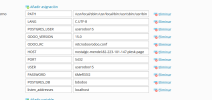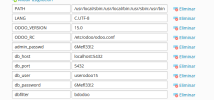In general Nginx configuration I use this configuration for Nginx reverse proxy to Odoo:
upstream odoo12a {
server 127.0.0.1:8012;
}
upstream odoo12a-im {
server 127.0.0.1:8072;
}
server {
listen 80;
server_name www.domain.com;
rewrite ^(.*) https://$host$1 permanent;
}
server {
listen 443;
server_name www.domain.com;
proxy_read_timeout 720s;
proxy_connect_timeout 720s;
proxy_send_timeout 720s;
proxy_set_header X-Forwarded-Host $host;
proxy_set_header X-Forwarded-For $proxy_add_x_forwarded_for;
proxy_set_header X-Forwarded-Proto $scheme;
proxy_set_header X-Real-IP $remote_addr;
ssl on;
ssl_certificate /etc/letsencrypt/live/www.domain.com/fullchain.pem; # managed by Certbot
ssl_certificate_key /etc/letsencrypt/live/www.domain.com/privkey.pem; # managed by Certbot
include /etc/letsencrypt/options-ssl-nginx.conf; # managed by Certbot
ssl_dhparam /etc/letsencrypt/ssl-dhparams.pem; # managed by Certbot
access_log /var/log/nginx/www_domain_com_odoo_access.log;
error_log /var/log/nginx/www_domain_com_odoo_.error.log;
location /longpolling {
proxy_pass http://odoo12a-im;
}
location / {
proxy_redirect off;
proxy_pass http://odoo12a;
}
location ~* /web/static/ {
proxy_cache_valid 200 60m;
proxy_buffering on;
expires 864000;
proxy_pass http://odoo12a;
}
gzip_types text/css text/scss text/plain text/xml application/xml application/json application/javascript;
gzip on;
}
But I don't know how achieve the same functionality with Plesk?, So the point of my question is how to create Nginx reverse proxy to the Odoo?
Thanks,
Tri
upstream odoo12a {
server 127.0.0.1:8012;
}
upstream odoo12a-im {
server 127.0.0.1:8072;
}
server {
listen 80;
server_name www.domain.com;
rewrite ^(.*) https://$host$1 permanent;
}
server {
listen 443;
server_name www.domain.com;
proxy_read_timeout 720s;
proxy_connect_timeout 720s;
proxy_send_timeout 720s;
proxy_set_header X-Forwarded-Host $host;
proxy_set_header X-Forwarded-For $proxy_add_x_forwarded_for;
proxy_set_header X-Forwarded-Proto $scheme;
proxy_set_header X-Real-IP $remote_addr;
ssl on;
ssl_certificate /etc/letsencrypt/live/www.domain.com/fullchain.pem; # managed by Certbot
ssl_certificate_key /etc/letsencrypt/live/www.domain.com/privkey.pem; # managed by Certbot
include /etc/letsencrypt/options-ssl-nginx.conf; # managed by Certbot
ssl_dhparam /etc/letsencrypt/ssl-dhparams.pem; # managed by Certbot
access_log /var/log/nginx/www_domain_com_odoo_access.log;
error_log /var/log/nginx/www_domain_com_odoo_.error.log;
location /longpolling {
proxy_pass http://odoo12a-im;
}
location / {
proxy_redirect off;
proxy_pass http://odoo12a;
}
location ~* /web/static/ {
proxy_cache_valid 200 60m;
proxy_buffering on;
expires 864000;
proxy_pass http://odoo12a;
}
gzip_types text/css text/scss text/plain text/xml application/xml application/json application/javascript;
gzip on;
}
But I don't know how achieve the same functionality with Plesk?, So the point of my question is how to create Nginx reverse proxy to the Odoo?
Thanks,
Tri


